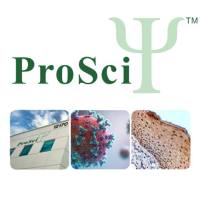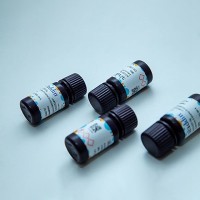Characterization of Corticotropin‐Releasing Factor (CRF) Receptors
互联网
- Abstract
- Table of Contents
- Materials
- Figures
- Literature Cited
Abstract
Corticotropin?releasing factor (CRF) and its receptors play a major role in regulating an organism's response to physical, emotional and environmental stress. While the primary role of CRF is the regulation of adrenocorticotropin hormone (ACTH) secretion from the pituitary and modulation of the hypothalamic?pituitary adrenal axis, CRF is also widely distributed in the central nervous system where it produces a broad spectrum of autonomic, electrophysiological and behavioral effects consistent with a neurotransmitter or neuromodulator role in the brain. Methods are provided for characterizing the receptor proteins through which CRF exerts its function. A well?characterized radioligand receptor binding assay is provided that yields quantitative information about the affinity and density of receptors in a variety of tissues, while another procedure utilizes similar kinetic theories but, in contrast to the homogenized or whole cell suspension approach, makes use of slide?mounted tissue sections.
Table of Contents
- Basic Protocol 1: Association Kinetic Assay to Determine Time Course for Equilibrium Binding
- Alternate Protocol 1: Kinetic Assay to Determine Dissociation Time Course
- Basic Protocol 2: Saturation (Scatchard) Assays to Determine KD and Bmax
- Basic Protocol 3: Competition Assays to Determine Ki Values of Competing Ligands
- Support Protocol 1: Preparation of Corticotropin‐Releasing Factor (CRF) Receptors from Tissues or Cells
- Basic Protocol 4: Receptor Autoradiography to Study Corticotropin‐Releasing Factor (CRF) Receptors
- Reagents and Solutions
- Commentary
- Literature Cited
- Figures
- Tables
Materials
Basic Protocol 1: Association Kinetic Assay to Determine Time Course for Equilibrium Binding
Materials
Alternate Protocol 1: Kinetic Assay to Determine Dissociation Time Course
Basic Protocol 2: Saturation (Scatchard) Assays to Determine KD and Bmax
Materials
Basic Protocol 3: Competition Assays to Determine Ki Values of Competing Ligands
Materials
Support Protocol 1: Preparation of Corticotropin‐Releasing Factor (CRF) Receptors from Tissues or Cells
Materials
Basic Protocol 4: Receptor Autoradiography to Study Corticotropin‐Releasing Factor (CRF) Receptors
Materials
|
Figures
-
Figure 1.13.1 Peptide sequences of human (A ) corticotropin‐releasing factor (CRF) and (B ) urocortin. View Image -
Figure 1.13.2 Association (A ) and dissociation (B ) of [125 I]sauvagine binding to human CRF2(a) receptors expressed in stable CHO cell lines. (A) For association experiments, cell membrane homogenates were incubated at 22°C with ∼100 to 200 pM [125 I]sauvagine for various times. Nonspecific binding was defined in the presence of 1 µM D ‐PheCRF(12‐41) at each time point. The association rate constant ( k +1 ) was determined (assuming pseudo‐first‐order kinetics) by plotting ln[Be /(Be ‐B)] versus time, where Be is specific binding (fmol/mg protein) at equilibrium and B is specific binding at any given time point. An example of such a plot is found in UNIT . Fig. k +1 was calculated from the equation k ob − k −1 = k +1 × CL, where k ob is the slope of the association plot described above, k −1 is the dissociation rate constant, and CL is ligand concentration. In the experiment described above, k +1 was observed to be 0.415 min−1 nmol−1 . (B) Following equilibrium, dissociation of [125 I]sauvagine was initiated by the addition of 1 µM D ‐PheCRF(12‐41), and the reaction was stopped at various times by centrifugation. Specific binding, B, was calculated for each time point, t , and the dissociation constant was determined from the equation ln(B/B0 ) = k −1 × t , where B0 is specific binding at equilibrium. In the experiment described above, k −1 was observed to be 0.0252 min−1 . View Image -
Figure 1.13.3 Saturation (A ) and Scatchard (B ) analyses of [125 I]sauvagine binding to human CRF2(a) receptors expressed in stable CHO cell lines. Human CRF2(a) receptor–transfected CHO cell membranes were incubated with 10 to 12 concentrations of [125 I]sauvagine (1 pM to 2 nM) at 22°C as described (see ). Nonspecific binding was defined in the presence of 1 µM D ‐Phe r/hCRF(12‐41) at each concentration. K D and B max values were estimated by nonlinear regression analysis using Prism software (GraphPad). View Image -
Figure 1.13.4 Competition of CRF‐related peptides for [125 I]sauvagine binding to human CRF2(a) receptors stably expressed in CHO cell lines. CRF2(a) ‐expressing cell membranes were incubated with 200 pM [125 I]sauvagine at 22°C along with varying concentrations of competing peptides, and were analyzed for the ability of competitors to inhibit binding. The rank order of potencies of these peptides defines the receptor subtype. That is, the rank order is identical for the CRF2(a) receptor subtype, regardless of the tissue or species from which it is derived. The rank order of potencies is sauvagine (3 nM), r/hCRF (20 nM), α‐helCRF(9‐41) (150 nM), and oCRF (300 nM). α‐helCRF, α‐helical oCRF(9‐41). View Image -
Figure 1.13.5 Localization of CRF1 and CRF2 receptor ligand binding sites by autoradiography using [125 I]sauvagine and [125 I]oCRF in rat brain. Horizontal slide‐mounted rat brain sections were incubated with either radiolabeled oCRF or sauvagine and apposed to film as described (see ). [125 I]oCRF (left) labels predominantly the CRF1 receptor subtype in the internal granular layer of the olfactory bulb, and in cortical and cerebellar regions, with virtually no labeling of the CRF2(a) subtype. [125 I]Sauvagine (right), which has equal affinity for both the CRF1 and CRF2(a) receptor subtypes, labels all of the same CRF1 receptor regions as [125 I]oCRF, and also labels regions high in CRF2(a) receptor density, such as the lateral septum, the choroid plexus, and the ependymal layer of the olfactory bulb. This confirms the apparent selectivity profile of the two radioligands, and is consistent with the rank order profile demonstrated in the competition studies. View Image
Videos
Literature Cited
| Literature Cited | |
| (Chadwick, D.J., Marsh, J., and Ackrill, K. (eds.). 1993. Corticotropin‐releasing factor. In CIBA Foundation Symposium, Vol.172. John Wiley & Sons, Chichester, England. | |
| Chalmers, D.T., Lovenberg, T.W., and De Souza, E.B. 1995. Localization of novel corticotropin‐releasing factor receptor (CRF2) mRNA to specific sub‐cortical nuclei in rat brain: Comparison with CRF1 receptor mRNA expression. J. Neurosci. 15:6340‐6350. | |
| Chalmers, D.T., Lovenberg, T.W., Grigoriadis, D.E., Behan, D.P., and De Souza, E.B. 1996. Corticotropin‐releasing factor receptors: From molecular biology to drug design. Trends Pharmacol. Sci. 17:166‐172. | |
| Chang, C.P., Pearse, R.I., O'Connell, S., and Rosenfeld, M.G. 1993. Identification of a seven transmembrane helix receptor for corticotropin‐releasing factor and sauvagine in mammalian brain. Neuron 11:1187‐1195. | |
| Chen, R., Lewis, K.A., Perrin, M.H., and Vale, W.W. 1993. Expression cloning of a human corticotropin‐releasing‐factor receptor. Proc. Natl. Acad. Sci. U.S.A. 90:8967‐8971. | |
| De Souza, E.B., and Grigoriadis, D.E. 1994. Corticotropin‐releasing factor: Physiology, pharmacology and role in central nervous system and immune disorders. In Psychopharmacology: The Fourth Generation of Progress (F.E. Bloom and D.J. Kupfer, eds.) pp. 505‐517. Raven Press, New York. | |
| De Souza, E.B. and Nemeroff, C.B. (eds.) 1990. Corticotropin‐Releasing Factor: Basic and Clinical Studies of a Neuropeptide. CRC Press, Boca Raton, Fla. | |
| Dunn, A.J. and Berridge, C.W. 1990. Physiological and behavioral responses to corticotropin‐releasing factor administration: Is CRF a mediator of anxiety of stress responses? Br. Res. Rev. 15:71‐100. | |
| Grigoriadis, D.E., Lovenberg, T.W., Chalmers, D.T., Liaw, C., and De Souza, E.B. 1996. Characterization of corticotropin‐releasing factor receptor subtypes. In Neuropeptides: Basic and Clinical Advances (J.N. Crawley and S. McLean, eds.) pp. 60‐80. The New York Academy of Sciences, New York. | |
| Gulyas, J., Rivier, C., Perrin, M., Koerber, S.C., Sutton, S., Corrigan, A., Lahrichi, S.L., Craig, A.G., Vale, W., and Rivier, J. 1995. Potent, structurally constrained agonists and competitive antagonists of corticotropin‐releasing factor. Proc. Natl. Acad. Sci. U.S.A. 92:10575‐10579. | |
| Kishimoto, T., Pearse, R.V.II., Lin, C.R., and Rosenfeld, M.G. 1995. A sauvagine/corticotropin‐releasing factor receptor expressed in heart and skeletal muscle. Proc. Natl. Acad. Sci. U.S.A. 92:1108‐1112. | |
| Kostich, W., Chen, A., Sperle, K., Horlick, R.A., Patterson, J., and Largent, B.L. 1996. Molecular cloning and expression analysis of human CRF receptor type 2α and β isoforms. Soc. Neurosci. Abstr. 22:1545. | |
| Liaw, C.W., Lovenberg, T.W., Barry, G., Oltersdorf, T., Grigoriadis, D.E., and De Souza, E.B. 1996. Cloning and characterization of the human CRF2 receptor gene and cDNA. Endocrinology 137:72‐77. | |
| Lovenberg, T.W., Liaw, C.W., Grigoriadis, D.E., Clevenger, W., Chalmers, D.T., De Souza, E.B., and Oltersdorf, T. 1995. Cloning and characterization of a functionally distinct corticotropin‐releasing factor receptor subtype from rat brain. Proc. Natl. Acad. Sci. U.S.A. 92:836‐840. | |
| Owens, M.J., and Nemeroff, C.B. 1991. Physiology and pharmacology of corticotropin‐releasing factor. Pharmacol. Rev. 43:425‐473. | |
| Perrin, M.H., Donaldson, C.J., Chen, R., Lewis, K.A., and Vale, W.W. 1993. Cloning and functional expression of a rat brain corticotropin releasing factor (CRF) receptor. Endocrinology 133:3058‐3061. | |
| Perrin, M., Donaldson, C., Chen, R., Blount, A., Berggren, T., Bilezikjian, L., Sawchenko, P., and Vale, W. 1995. Identification of a second corticotropin‐releasing factor receptor gene and characterization of a cDNA expressed in heart. Proc. Natl. Acad. Sci. U.S.A. 92:2969‐2973. | |
| Phelan, M.C. 1998. Techniques for mammalian cell tissue culture. In Current Protocols in Molecular Biology (F.M. Ausubel, R. Brent, R.E. Kingston, D.D. Moore, J.G. Seidman, J.A. Smith, and K. Struhl, eds.) pp. A.3F.1‐A.3F.14. John Wiley & Sons, New York. | |
| Rivier, J., Rivier, C., Galyean, R., Miranda, A., Miller, C., Craig, A.G., Yamamoto, G., Brown, M., and Vale, W. 1993. Single point D‐substituted corticotropin‐releasing factor (CRF) analogs: Effect on potency and physicochemical characteristics. J. Med. Chem. 36:2851‐2859. | |
| Sperle, K., Chen, A., Kostich, W., and Largent, B.L. 1997. CRH2γ: A novel CRH2 receptor isoform found in human brain. Soc. Neurosci. Abstr. 23:689.14. | |
| Vita, N., Laurent, P., Lefort, S., Chalon, P., Lelias, J.M., Kaghad, M., Le, F.G., Caput, D., and Ferrara, P. 1993. Primary structure and functional expression of mouse pituitary and human brain corticotrophin releasing factor receptors. FEBS Lett. 335:1‐5. | |
| Webster, E.L., Lewis, D.B., Torpy, D.J., Zachman, E.K., Rice, K.C., and Chrousos, G.P. 1996. In vivo and in vitro characterization of antalarmin, a nonpeptide corticotropin‐releasing hormone (CRH) receptor antagonist: Suppression of pituitary ACTH release and peripheral inflammation. Endocrinology. 137:5747‐5750. |






